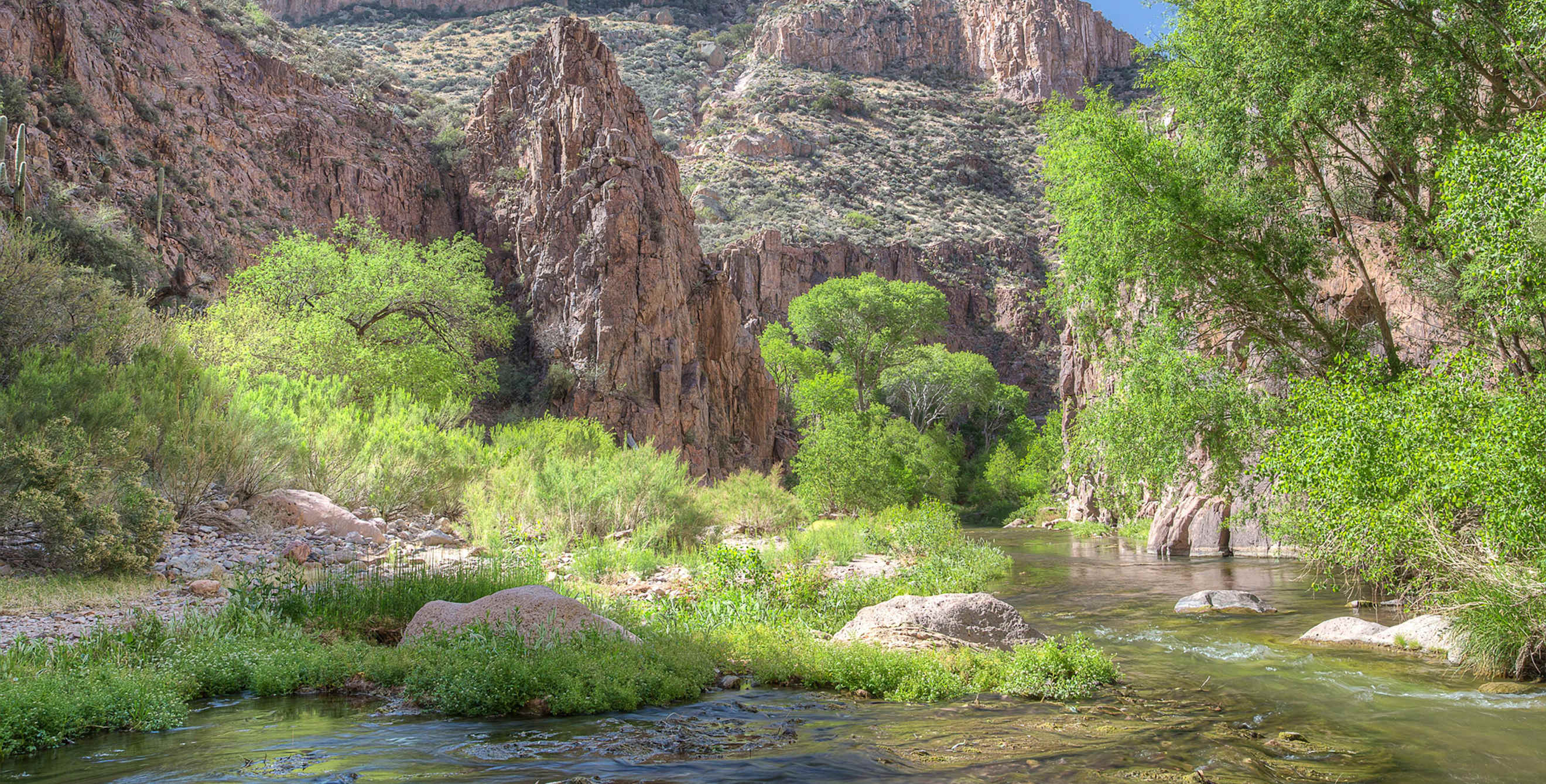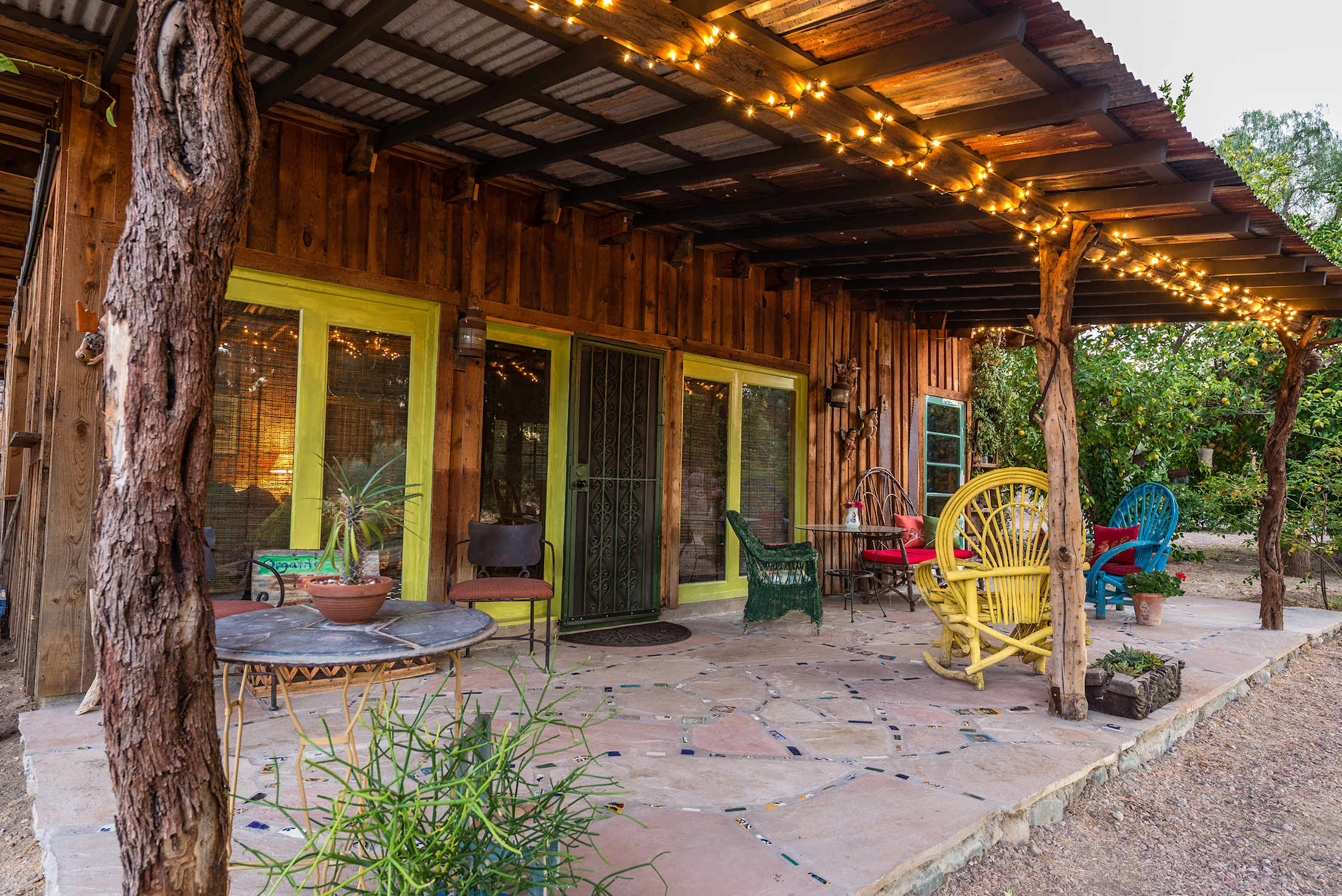
5 Peaceful Spring Break Spots in Arizona
These escapes provide quietude, meditative ambiance, and a chance to reconnect with nature.

There was a time when spring break meant staking your claim on a crowded beach by day and jamming to beats in a bar at night. These days, when our nerves are frazzled by constant screen time, Sisyphean to-do lists, and stressful commutes, many of us dream of peaceful, quiet escapes. It’s no surprise that experts predict silent travel will be popular in 2024, dovetailing with similar trends like mindfulness retreats and digital detoxing. Thankfully, Arizona offers a wellspring of stillness and serenity that’s perfect for a springtime escape.
Gila Box Riparian National Conservation Area
Most people haven’t heard of this lush, 23,000-acre canyonland in Eastern Arizona, and that’s great news if you’re looking for solitude. Four waterways—the Gila and San Francisco rivers, and Bonita and Eagle creeks—weave between cottonwoods and towering cliffs in this gorgeous hiking region. We can’t honestly say you’ll have the trails to yourself, though because there aren’t any trails. Amble in untrammeled mesquite woodlands and along sandy riverbanks as you keep an eye out for bighorn sheep, ancient rock art, and 100-plus species of birds.
To navigate the scenic backcountry roads, the Bureau of Land Management recommends a four-wheel-drive vehicle or a mountain bike. At night, you can pitch your tent at the Riverview Campground, which offers potable water, bathrooms, grills, and stunning vistas.
Canyon de Chelly
If you’re feeling bombarded by TikTok trends and artificial intelligence debates, a journey to this sacred canyon can offer a refreshingly enlightening perspective. Diné, or Navajo, people have been living in kinship with this land for thousands of years, farming and raising livestock while continuing ancient traditions. Because this is tribal land, it’s necessary to venture into the canyon on a hiking or Jeep tour with a Navajo guide. All of Canyon de Chelly Tours’ guides are Diné, and many were born in the canyon. Depending on your guide, you may learn about Navajo mythology, medicinal and edible plants, or deep history. You might even be serenaded with flute music.
You can overnight in hotels at nearby Chinle, but for a more peaceful and authentic milieu, consider staying in a Navajo hogan or earthen home. Locals rent these traditional dwellings through home rental sites. You can find some near Chinle or Monument Valley—another quiet, stunning landscape about an hour and a half away from Canyon de Chelly.

Aravaipa Canyon Wilderness
Only 50 people per day are allowed in this 19,410-acre wilderness—20 from the remote East Trailhead and 30 from the West Trailhead, which is more accessible for travelers coming from Phoenix or Tucson. With so few people, the primary sound you’ll hear is the splash of your feet in Aravaipa Creek. In this trail-free landscape, the waterway is the path much of the time. For that reason, you should bring waders, gaiters, and/or shoes you don’t mind soaking, plus hiking poles to keep you steady in slippery spots. The reward is childlike water play and a feeling of freedom as you saunter among the sycamores and cottonwoods, then explore side canyons and caves carved out of the sienna cliffs. If you’re lucky, you’ll spot desert bighorn sheep, javelina, deer, and some of the 200-plus species of birds that frolic throughout this riparian ecosystem.
Though there are no designated campsites, you can backpack and wild camp in the canyon (book a required permit for day trips or overnight stays in Aravaipa Canyon in advance). Alternatively, stay in a cushy, colorful casita or Airstream at Aravaipa Farms Orchard & Inn.
Chiricahua National Monument
In this remote southeastern corner of Arizona, golden hoodoos freckled with chartreuse lichen stand like a gathering of sun-worshipers on the mountain slopes. Fortunately, funky rock formations are the only things crowding this wanderer’s wonderland. You’re unlikely to encounter many people even on the popular 3.3-mile Echo Canyon Loop Trail or the 7.3-mile Heart of Rocks Trail that meanders among the totem-like stone towers. But if it’s solitude you seek, the 4.8-mile Natural Bridge Trail, which winds through woodlands spiced with juniper and pine, is billed as the monument’s “least used trail.”
You can camp in a shady oak and pine grove at Bonita Canyon campground, which offers running water and restrooms. Alternatively, bed down at The Huts at Rhumb Line Vineyard & Lavender Farm, where you can kick back with a glass of red or white from one of Willcox’s wineries, gaze at the Dos Cabezas Mountains, and breathe the aromatherapeutic air.

Do a meditation retreat
Arizona is home to several sites where you can slow down your brain waves and say “om,” from luxury silent retreats in Sedona to more modest mountainside getaways. On a three-day self-guided retreat at Diamond Mountain Retreat Center near Bowie, your daily schedule is filled with activities. But don’t worry: Your tasks consist of things like “sit with the sunset,” “hug your cat,” “gratitude meditation,” “dance in your room,” and—oh, sweet bliss!—“nap.” Founded by Buddhists but open to anyone, including newbie meditators, the center offers educational videos and other resources to support your meditation journey. You’ll stay in your own house with a kitchen and dedicated meditation space and enjoy vast mountain views; prices start at $300 for five nights or less, self-catered.
Alternatively, Dharma Treasure in the Dragoon Mountains supports solo meditation retreats for meditators from any tradition, or no tradition. You’ll meet with a trained Buddhist meditation teacher early in your stay to personalize your schedule, which may include walking meditations, exercise, meal preparation, and personal time. Prices start at $65 per night for glamping or $150 for an apartment or hut; solo retreats must be a minimum of three nights.